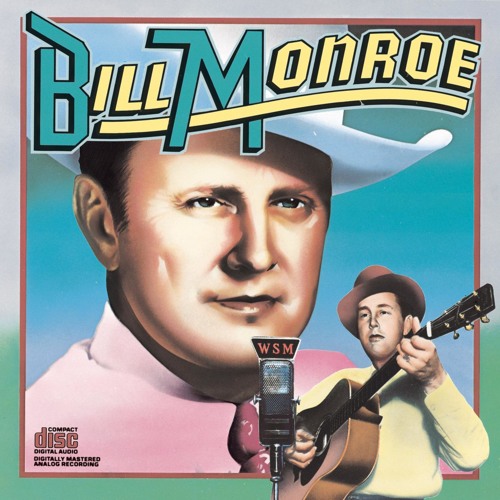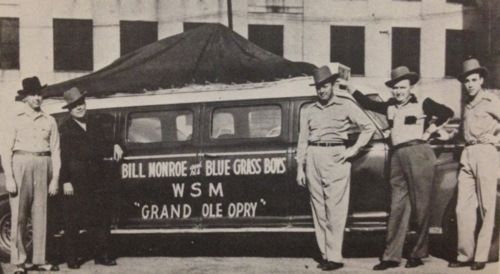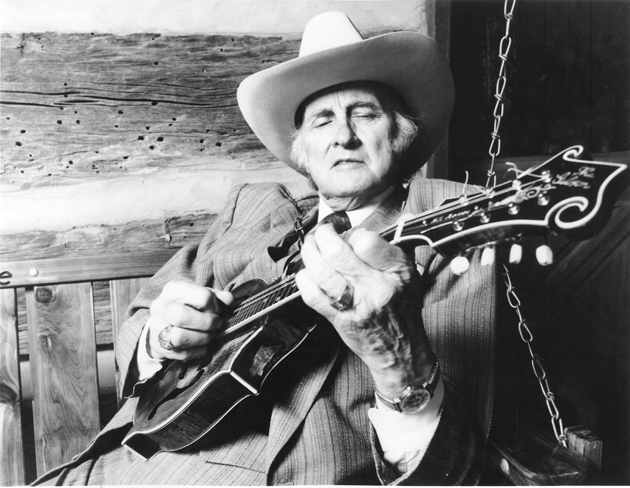A handful of musicians and performers
can be said to have laid the groundwork for and popularized whole
genres of American music—Scott Joplin with ragtime, Louis Armstrong
with jazz, Robert Johnson with Delta
blues, Jimmie Rodgers with
modern country music, and perhaps Elvis Presley for rock and roll. Only one, in the words of an admiring Ricky Skaggs “…was so influential…he’s probably
the only musician that had a whole style of music named after his band.”
That was Bill Monroe. His band
was called the Blue Grass Boys.
Monroe was born a hundred and ten
years ago on September 13, 1911 on a hard scrabble farm near Rosine, Kentucky. He was the youngest of 8 children. His
mother’s sides of the family, the Vandivers,
were popular local performers at barn dances. His brothers formed
a home band. As the youngest he was given the mandolin,
a background instrument to the lead fiddle and guitar.
His mother, the inspiration for the
family band, died when he was ten. His father six years later. His
older brothers drifted away, and the young man bounced from relative to
relative. Eventually he stayed with his mother’s brother Uncle Pen Vandiver and began performing
with him. Monroe credited his uncle with providing him with a base
repertoire of fiddle tunes and ballads from which he would
latter create his new sound.
During this time, he also picked up
elements of the blues plus ideas about a radical new guitar style—the thumb
picking style—from legendary Black fiddle
player and guitarist Arnold Shultz.
At the age of 18 Monroe and his
brothers Birch and Charley drifted north to find work in
an Indiana oil refinery. They
formed the Monroe Brothers Band and
were soon playing regularly on weekends. After Birch left the band Bill
and Charley kept on as a duo. Soon they were being featured on local radio broadcasts. That led to
touring honky-tonks from Indiana to Iowa and leaving behind the refinery.
By 1936 they had achieved enough of
a following to be signed to RCA’s
Bluebird label—the company’s ghetto for blues, country, and other non-mainstream
performers. Their first single, a gospel
number, What Would You Give In Exchange For Your Soul? Was a hit.
The boys recorded 60 sides for Bluebird over the next two years.
The brothers broke up their act in
’38. A few months later Bill put together the first version of the Blue
Grass boys in Atlanta. The
following year he won a regular spot on Nashville’s
Grand Ol’ Opry where the band’s lighting fast instrumental work and
tight harmonies featuring his high tenor were a sensation.
RCA singed Monroe to its main label. A dazzling version of Jimmie
Rodgers Mule Skinner Blues was among the new releases.
His signature sound was on its way,
but not yet fully formed. In 1944 Monroe added a banjo player to
the lineup—David “Stringbean” Akeman. But Akeman’s primitive
rhythmic strumming style was seldom used in the break-out solos that were becoming the hallmark of the
band. The same year he incorporated and discarded an accordion borrowed from the Cajun sound.
Things came together in late ’45
when Earl Scruggs replaced Stringbean on banjo. Scruggs’s
revolutionary three finger picking style
instantly made the banjo one of the lead instruments in the new sound.
Along with Lester Flatt, master of the thumb picking style of guitar and
a lead singer to blend with Monroe’s high tenor on close harmonies, the new
line-up included fiddler Chubby Wise,
and bassist Howard Watts. With
this accomplished band of musicians, the improvisational solo breaks and
instrumental duels influenced by
jazz created a signature new sound from traditional material. Some
historians dub this version of the band as “THE Original Bluegrass Band.”
Although Flatt and Scruggs would
leave after a few years to form their own influential group, Monroe seamlessly
introduced new and accomplished pickers in the new style to the rotating cast
of the Blue Grass Boys. From the late 40’s through much of the
‘50’s Monroe and his band were riding high on the country charts selling
millions of records on the Columbia label including his signature song, Blue Moon of Kentucky.
A nearly fatal automobile
accident in 1953 slowed him down some, but he soon resumed touring with his
band.
But record sales and demand for
personal appearances dropped sharply in the late ‘50’s and early ‘60’s with the
emergence of rock ‘n’ roll and the cross-over sophistication of
the Nashville Sound. Although regular Opry appearances kept him in
the public mind, he sometimes struggled to find enough tour dates to keep his
band together.
His former band members Flatt and Scruggs were the first to discover and exploit a new market for their music in the folk music boom of the early ‘60’s. Monroe was first reluctant to follow suit, but a new manager was soon booking him on more northern dates, including big cities and college campuses where he found an exciting new audience. In fact, it was this folk audience that dubbed the whole style of music that he pioneered with the new name Bluegrass music. He even began to include young northerners in his band.
By the mid ‘60’s Bluegrass festivals
were popping up all over the country. Monroe started his own, at his Bean
Blossom, Indiana park and campgrounds. Today called the Bill
Monroe Festival, it is the longest continually running Bluegrass festival in
the world. The far flung new festivals gave Monroe a regular circuit
even after the folk music scene subsided and Bluegrass split entirely from mainstream
country music.
Monroe settled into a role as inspiration
and mentor for generations of young musicians while continuing to
perform. Ricky Skaggs, for instance, first appeared with Monroe on stage
at age 8. In the ‘80’s he put out enormously successful and influential
albums of duets. One featured country music stars Emmylou Harris, Waylon
Jennings, and the Oak Ridge Boys among
others. The second featured duets with other Bluegrass greats. He
topped off the decade with a 1989 live album celebrating his 50 years as an
Opry star.
Monroe continued to record, tour and
perform almost to the end. He suffered as stroke in 1996.
Four months later, on September 6, he was dead.
His lists of honors and awards
is too long to list except that he is one of a handful of musicians enshrined
in the Country Music Hall of Fame,
the Nashville Songwriters Hall of Fame,
and the Rock and Roll Hall of Fame.
His most enduring legacy, however, is in the legions of musicians her performed
with or influenced. Over 150 different players performed at one time or
another with the Blue Grass Boys, many going on to long careers. He
shared the stage and influenced many others.
Any time you hear that high,
lonesome vocal harmony, extraordinary and improvisational solos, and tight
ensemble music that is the hallmark of Bluegrass, you are listening to the
spirit of Bill Monroe.







No comments:
Post a Comment